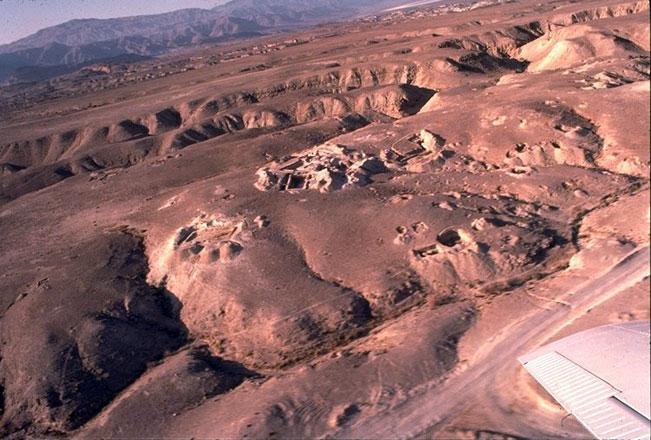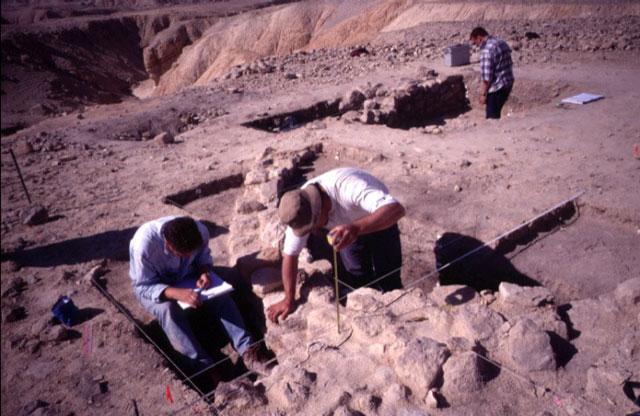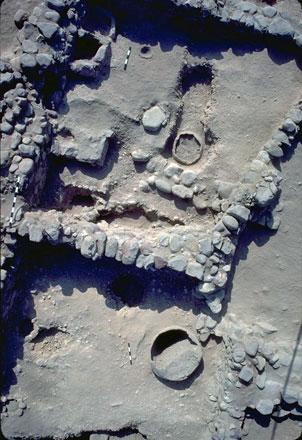You are here
US scholar researches diversity in Early Bronze Age Dead Sea urbanism
By Saeb Rawashdeh - Jun 03,2018 - Last updated at Jun 04,2018

Crashed skeletons at Numayra near the southern Dead Sea (Photo courtesy of Meredith Chesson)
AMMAN — The fascinating nature of urbanism, revealed by Jordan’s archaeological sites, motivated Meredith Chesson, an American anthropologist who received her PhD from Harvard in 1997, to conduct research on several Early Bronze Age (EBA) sites near the Dead Sea.
Some 5,000 years ago, EBA people invented a new type of settlement, characterised by cities surrounded by fortification walls and left the countryside to move into these, Chesson explained, noting that no evidence of warfare or conflict throughout the southern Levant has been recorded to account for why these populations suddenly decided to live in fortified towns.
“Perhaps the threat of conflict was great enough, or there were other reasons that pushed them to build walls around their settlements,” the scholar commented, stressing that, regardless of the reasons, EBA people decided to leave their farmsteads and villages to move into these “large and walled communities”. “This is when small-scale EBA urbanism was born,” Chesson claimed.
Researchers found strong evidence of Egyptian people and products present in many communities at the beginning of the EBA. But, by the time the third millennium BC rolled around, the southern Levantine EBA people had developed an inwardly focused society, she explained.
According to the anthropologist, substantial trade with Mesopotamian and Egyptian neighbours largely disappeared. Unlike their regional peers, the EBA people in the southern Levant did not adopt writing systems or standardised weights and measures, which are typically seen as hallmarks of ancient urbanism in the Near East.
“We see the EBA people borrowing practices from their neighbours, like seal impressions, but, instead of using seals like economic receipts and locks on storeroom doors, they used seals to decorate their pottery vessels,” she explained, highlighting that the EBA people in the region took the decision to focus their trade within the region, and to develop different tools for managing civic structures and densely populated settlements.
“Each town or city had its own specific history and organisation,” the American scholar emphasised, noting that such diversity meant that many of these communities shared the same types of houses and architectural technologies, suites of ceramic vessels and stone tools and agricultural crops and animal husbandry practices.
“However, the specific combinations of these generalised EBA ingredients differed from community to community,” Chesson pointed out.
For instance, Bab adh-Dhra’ and Numayra were located only 13 kms from each other and inhabited at the same time. Yet, the Dead Sea Plain excavations found evidence that the towns were organised differently and that people grew different crops, despite being located in the same environmental zone, she highlighted.
“Sometimes, walled sites were very small, like Numayra, which we estimate to have been only one hectare in size, or the neighbouring walled town of Bab adh-Dhra, which was approximately four hectares,” Chesson noted, adding that “other sites, however, were much larger: Khirbat as-Zaraqon, near Irbid, was roughly seven hectares large, while Tall Al Handaquq South, near Dayr ‘Alla, was about 15 hectares in size”.
“The bigger the site, the more complexity we see in terms of how many people lived in the community, how they fed and supported these large populations, and how they organised their towns. For instance, 25-hectare Bet Yerah has some really good evidence for what we call today city planning, but one-hectare Numayra didn’t seem to have any governing plan or guide of how to build homes, streets, public spaces, or fortification walls,” Chesson outlined.
“These EBA peoples created unique solutions for forming and sustaining their communities throughout the region, and I think that [their] centuries-long success and ultimate failure can offer lessons in sustainability for our own world today,” Chesson concluded.
Related Articles
AMMAN — Scholars researching the Early Bronze Age (EBA) (2000–1500BC) in the region say people during this period likely faced some of the s
AMMAN — The early inhabitants of Lisan Peninsula, on the southern corner of the Dead Sea, explored the potential of the spring waters for ir
AMMAN — Numeira, an archaeological site in Jordan near the southern Dead Sea, offers some of the best preserved excavated houses of the wall


















